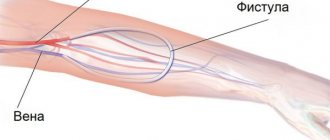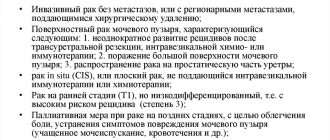general information
Hemodialysis (“artificial kidney machine”) is a procedure performed to restore kidney function in cases of acute or chronic failure. With this disease, the organ cannot cope with its functions and toxins accumulate in the body along with urine.
Let's consider the essence of the hemodialysis procedure: with the help of a special drug, the patient's blood is cleared of toxic substances, and the water-electrolyte balance is adjusted.
If the patient is on constant dialysis, then a special fistula is installed. This is a kind of “vascular place” from which contaminated blood is removed and returned back in a purified form.
Thanks to this device, the walls of the venous vessels expand significantly and blood circulation through them accelerates.
This is what causes difficulties when taking a puncture. Doctors have found a unique method of installing a fistula, which simplifies the process of blood purification. It is worth noting that suturing of blood vessels is carried out only on one arm.
Arteriovenous fistula and its features
This is a special shunt that is installed between an artery and a vein. Thus, the walls of blood vessels are sealed and the process of cleansing the blood of toxins is accelerated.
It is located under the skin, is not subject to the formation of blood clots, and a puncture needle is easily inserted into it.
There are several types of arteriovenous fistula: radiocephalic, brachiocephalic, brachiobasilar. Depending on the diameter of the vessel used, radial and brachial fistula are distinguished.
However, even this procedure has its advantages and disadvantages. Among the advantages are:
- the device is created exclusively from human vessels, no foreign materials are used;
- is located clearly under the skin;
- infection and blood clot formation are excluded;
- with proper care can be used for up to 10 years;
- Scientists are constantly improving this device.
Disadvantages include:
- the maturation of the fistula lasts up to 60 days;
- there is a risk that the device will not mature due to a number of negative factors: poor circulatory pressure, a small area of the operated vessels, etc.
In addition to this type of device, a hemodialysis patient can have an artificial prosthesis or catheter installed. They are much inferior in functionality to AVFs, so they are not used often.
If the kidney is the second heart of a person (this organ performs so many functions), then for a patient on hemodialysis this role is to some extent performed by a fistula. The word, unfamiliar to most people, means “vascular access” - the place from which a significant amount of blood is taken for purification in the “artificial kidney” machine and where it is returned in a form purified from toxins. Usually this is the hand, forearm, although if absolutely necessary there may be other human organs.
So, the normal functioning of the body involves the flow of blood from the heart through the arteries into the capillaries, then the movement occurs back through the veins. An arteriovenous fistula is an artificially created anastomosis of an artery and a vein; they are “stitched” - as a result, the blood moves along the communication between the vein and the artery, bypassing the capillary network. Naturally, the blood flow increases, the vein swells - which makes it possible to quickly pump blood through special needles.
— Is it possible to do without surgery?
The operation to form a fistula is considered simple, if the vessels are sufficiently developed and there are no concomitant diseases, then it will last about 40 minutes. In this case, the patient remains fully conscious, the operation is performed under local anesthesia.
If the natural formation of a fistula is impossible for some reason, then special vascular prostheses are used - tubes that replace part of the vein. They can be punctured within 24 hours after surgery. A fistula formed “naturally” must be protected. It is not recommended to inject it for at least a month. The fistula should “mature” and swell with blood. Otherwise, the artificially created anastomosis of the artery and vein may be disrupted, and the fistula will “stop.”
— Prepare for dialysis in advance
Considering the importance of a fistula for the entire future life of a dialysis patient, experts recommend forming a fistula in advance, as planned, several months before the start of dialysis. This guarantees long-term operation of the fistula and the absence of additional problems during hemodialysis.
True, most patients end up on dialysis too late - when the body is already poisoned with toxins due to poorly functioning kidneys and when the count is already weeks, or even days. Therefore, they have to urgently provide temporary vascular access - through catheters in the central veins - subclavian or jugular, located in the neck and carrying blood away from the neck and head.
- Why is she making so much noise?
A newcomer with a newly formed fistula is quite easy to recognize - as a rule, the patient “listens” to it every now and then. To do this, simply press the operated hand to your ear. This pulsating, slightly whistling sound is difficult to confuse with something else. To some people it resembles the noise of working presses or machines. This pumps blood through swollen veins. The noise should be rhythmic and always the same. If there is any change in sound, you must immediately show your doctor. And if suddenly the noise disappears, urgently go to the dialysis center - the fistula could stop, thrombose. Sometimes blood clots can be removed surgically or with medication.
— From the history of the creation of fistula
It’s not for nothing that they say that everything ingenious is simple. Despite its apparent simplicity, the idea of creating an arteriovenous fistula did not immediately make its way among other scientific inventions. In the first years of dialysis, scientists had to struggle a lot with this problem. At first, a cannula was used as a vascular access - a tube that was surgically fixed and “grafted” to the patient’s vessels.
The beginning of the era of chronic hemodialysis is considered to be 1960, when Belding Scribner and Wayne Quinton from the American city of Chicago managed to solve the problem of long-term vascular access. In them, long-term vascular access was provided by implanting two thin-walled Teflon tubes into the radial artery and saphenous vein. The outer ends of the shunt were connected by a curved Teflon tube, which was removed during hemodialysis, and a hemodialyzer was connected to the shunts.
Preparation for the procedure
The fistula is installed surgically. Before this, it is imperative to undergo diagnostics of the cardiovascular system and establish the usefulness of the kidneys.
Examination and tests
Diagnostic procedures include:
- Ultrasound of the cardiovascular system and kidneys;
- assessment of heart function;
- complex of liver-renal tests;
- angiographic examination of the circulatory system;
- fluorography;
- blood and urine tests (general, biochemical parameters, hepatitis, HIV).
Be sure to tell your doctor if you are taking anti-inflammatory or blood thinning medications, as they may affect the progress of the surgical procedure.
Stages of passage
The installation procedure is simple and, if the doctor is sufficiently experienced, takes no more than an hour. Local anesthesia is used, and the shunt is installed mainly on one arm.
In rare cases, when there are not enough human vessels, the doctor may use special medical catheters or tubes, they replace certain sections of the vein. It takes an average of 30 to 60 days for the fistula to swell; during this period it is strictly forbidden to puncture or injure it.
The essence of the operation is to carry out the following manipulations:
- injecting local anesthesia into the patient's arm;
- treatment of the incision site;
- then the doctor makes an incision in the skin and ligates the necessary artery, then crosses it;
- at the next stage, the lateral venous vessel is removed and a clamp is applied to it;
- then these two vessels are dissected and stitched together;
- At the last stage, the doctor heals the incision on the arm and applies a sterile surgical dressing.
During the operation, the patient does not feel pain; in the future, proper care of this device is very important.
Fistula Care
Proper fistula care begins before surgery. To form a fistula, sufficient development of blood vessels is necessary, so the veins on the forearm must be protected and not punctured.
Dialysis will begin after the fistula has matured, guaranteeing quality and long service life. To prolong the service life of a hemodialysis fistula, follow the recommendations:
- After the operation, you need to give your hand rest. It is advisable to keep it elevated for more time;
- When enough time has passed, the doctor will allow you to put stress on the arm with the fistula, but not excessively. It is important to avoid inactivity and overload;
- dry the fistula daily;
- It is important to listen to the noise from the fistula. It shouldn’t change dramatically; if this happens, it’s time to see a doctor;
- observe hygiene measures;
- avoid sleeping on the arm with a fistula;
- monitor blood pressure, avoiding sudden jumps;
- a hand with a fistula is not used to draw blood for analysis or measure pressure.
Prolonged maturation of the fistula is the main disadvantage of the procedure
The patient will have to constantly monitor the condition of the fistula. It's not difficult, it becomes a habit, like brushing your teeth. You need to visually and by touch assess whether everything is in order.
Swelling, redness of the skin are deviations from the norm; if such changes are detected, you should immediately consult a doctor. Using a stethoscope, you can listen to noises inside the fistula and assess the speed of blood flow. The doctor will explain what to look for.
Gently touching the surgical site will not cause any harm to the patient. Vibration is a normal sensation; there should be no pain from touching it.
How to care for a fistula
To get an ideal fistula, you need to take care of the venous vessels and not subject them to frequent punctures. There are certain requirements for caring for this device.
If the patient wants to keep it in a functional state for as long as possible, then it is necessary to strictly adhere to all recommendations. Let's consider this issue in more detail.
Checking status
During the postoperative period, it is necessary to keep the operated arm strictly at rest; it is forbidden to lift heavy things or sleep on this side.
To check the operation of the device, it is recommended to carefully monitor the noise that comes from it: it should be the same, continuous and distinct. In case of any violations, it is recommended to immediately consult a doctor.
Maintaining personal hygiene
An important condition is compliance with the rules of personal hygiene.
It is necessary to ensure the cleanliness of the hand on which the fistula is installed and periodically treat it with disinfectant solutions.
It is recommended to wash with soap that has a neutral pH.
The use of creams, lotions or other perfumes is strictly prohibited. The surface of the skin should be dry.
Arteriovenous fistula for hemodialysis
Hemodialysis is a procedure for purifying the blood in patients whose kidneys cannot cope with this function. A fistula is a natural or artificially created fistula, that is, a channel that connects any body cavities or a cavity with the external environment. An arteriovenous fistula for hemodialysis is an artificial fistula necessary for access to the blood system. The essence of the operation is that the artery is connected directly to the vein, due to which the vessel thickens, and it becomes easier to connect it to a blood purification device (“artificial kidney”).
Indications for surgery
The most common indication for hemodialysis is chronic renal failure. It is also necessary for poisoning by toxins or poisons. In a healthy person, the kidneys act as a kind of filter, controlling the amount of water in the body and purifying the blood of toxins. In 5 minutes, absolutely all the blood passes through the kidneys and circulates through the vascular bed. In one day, the kidneys manage to filter more than 180 liters of blood, while toxins are excreted in the urine.
In case of chronic renal failure, the blood must be filtered artificially, since the patient’s body cannot cope with this task. For these purposes, special devices were developed. With chronic dialysis, that is, the patient is regularly connected to the device, it is necessary to have constant access to the vascular bed. To do this, simple operations are performed to create a fistula, which will allow obtaining the maximum amount of blood for purification.
Method of operation
Before surgery, the patient must undergo a complete medical examination. Doctors pay attention not only to the condition of the kidneys and urinary system, but also take blood for analysis, examine the heart and blood vessels. The fistula for hemodialysis is located on the forearm, and the operation itself takes place in several stages.
- The procedure is performed under local anesthesia. After this, the surgical access site is disinfected.
- Next, a skin incision is made on the forearm, the artery is exposed, it is ligated and all its lateral branches are blocked.
- Then the surgeon works with the vein at a distance of 4-5 cm from the artery. You need to do the same manipulations with it as with the artery.
- Next, these two vessels need to be sewn together. To do this, a small longitudinal incision (2─2.5 cm) is made so that a suture can be placed on the edges of the vessels.
- At the end of the operation, the wound is sutured layer by layer and covered with a bandage.
After the procedure, time must pass until the fistula forms. During the first week, the patient must be in the hospital so that doctors can constantly monitor him. Discharge usually occurs on days 7-10, but even after that the patient comes to the hospital for examination. Hemodialysis using a fistula can be performed no earlier than a month after surgery.
Postoperative care
A mature arteriovenous fistula looks like an abscess on the forearm. If treated properly, it can last for many years and even decades without complications. To do this, the patient needs to get used to it and follow some instructions:
- do not put pressure on the arm on which the fistula is located (do not sleep on it, do not wear jewelry or clothes with tight sleeves);
- exclude physical activity (you can use your hand in everyday life, but sports will be contraindicated);
- do not measure pressure on this arm;
- listen to the noise ─ it should be the same all the time;
- if possible, do not provoke surges in blood pressure.
You need to understand that with any pathologies you need to consult a doctor. If the nature of the blood noise in the fistula has changed or bleeding does not stop for a long time after dialysis, the patient needs to be examined. An increase in local temperature should also be a cause for concern - this fact indicates the presence of inflammation. This situation can happen if hygiene is not maintained, especially after dialysis.
The patient must constantly raise his hand to his ear and listen to the noise. It should be drawn out, constant and rhythmic. This sound resembles the operation of mechanisms and is formed when blood moves through the veins. Any disturbance of this sound is a reason to consult a doctor. Decreased audibility or complete absence of sounds indicates the formation of blood clots, which must be removed surgically.
At first, many patients are afraid to touch the fistula and use their hand, but then they get used to the new way of life. You can and should touch it - this is the only way to feel the movement of blood through the connected vessels and control the local temperature.
There is no need to worry that light household loads will be harmful. On the contrary, moderate movements will prevent blood stagnation and keep the fistula in working condition for a long time.
Advantages of arteriovenous fistula over other methods
An arteriovenous fistula is not the only way to gain access to the vascular bed for hemodialysis. Artificial fistulas, subclavian or femoral catheters are also used. There is also a method of peritoneal dialysis, which does not require vascular access. Sterile liquid is poured through a special catheter tube directly into the abdominal cavity, and the filter in this case is the peritoneum. Then the solution is drained.
However, an arteriovenous fistula is considered the best option for the patient and, if there are several options, it is chosen. There are several reasons for this:
- To create a fistula, the patient’s own tissue is taken, which cannot cause rejection or allergies, unlike artificial materials.
- The fistula is located just under the skin and is easy to use to gain access to blood.
- The risk of infection, as well as the formation of blood clots, is minimal with this method.
- The same fistula can last for many years if properly cared for.
The result of treatment depends not only on hemodialysis, but also on the responsibility of the patient himself. Arteriovenous fistula is one of the most gentle and affordable options for chronic renal failure. Compared to other methods of blood purification and kidney transplant surgery, this procedure is the safest.
Disadvantages and possible complications
Unfortunately, this method is not suitable for all patients. If the patient has low blood pressure or anemia, after suturing the vessels, a fistula may not form. In this case, it will be impossible to access the vessel through a non-working fistula. Among the disadvantages, one can also highlight the duration of fistula maturation. The first hemodialysis can be performed only a month after the operation.
Complications occur in rare cases. Among them are possible:
- formation of an aneurysm (expansion of the walls of blood vessels with the danger of their rupture);
- decreased or loss of sensitivity in the hand;
- insufficient oxygen supply to the myocardium;
- compression of the carpal (wrist) nerve, which can cause the hand to function less well.
Complications appear in isolated cases. You need to understand that chronic renal failure is a disease that the patient will have to fight all his life. In this case, a person needs to get used to a new lifestyle, constant procedures, prohibitions and diet. A hemodialysis fistula allows for regular blood purification without any particular danger to the body.
Sources: https://fok-zdorovie.ru/ochishhenie-organizma/fistula-dlya-gemodializa-osobennosti-ispolzovaniya-i-uhod https://fok-zdorovie.ru/ochishhenie-organizma/fistula-dlya-gemodializa-osobennosti -ispolzovaniya-i-uhod https://pochkizdrav.ru/pochechnaya-nedostatochnost/fistula-dlya-gemodializa.html https://toxikos.ru/otravleniya/forsirovanniy-diurez
Complications and prognosis
If used incorrectly, the patient may encounter the following complications:
- infection;
- poor blood flow;
- development of chronic heart failure;
- blood clot formation;
- strokes of ischemic nature;
- aneurysm at the site of the fistula.
When the first unpleasant signs appear, you should immediately contact the institution where the operation was performed.
In the absence of associated complications, the installation of an AVF is positive. This also applies to its timely removal.








